As profit focused farmers it would be right to ask ourselves the above question.
We have been testing all heifers born on the farm since autumn 2011 and clearly with a cost of around £30 a test this is not a cheap exercise.
If we look at industry use in the UK then we can see that while on the increase, the uptake of whole herd genomic testing, or indeed any significant amount of testing, has been slow and still not at a level where any real effect will be seen on the national herd. A very few mad fools like us are testing all calves but mostly a few people have tested a few animals. It is interesting to note that the number one sire of tested animals is Shottle, followed by Uno, Silver, Goldwyn and Tiergan.
Out of these only Silver is a current Young Genomic Bull, all the others have full proofs, Shottle was born in 1999, Goldwyn in 2000, and Tiergan in 2005. It is interesting to note that 80% of herds doing any testing have tested less than 20 animals. Clearly milk prices have had a huge effect on the uptake of this technology, but it looks like quite a few farmers have tried a couple and not seen the value in it (Figure 1).
Figure 1: Industry Use
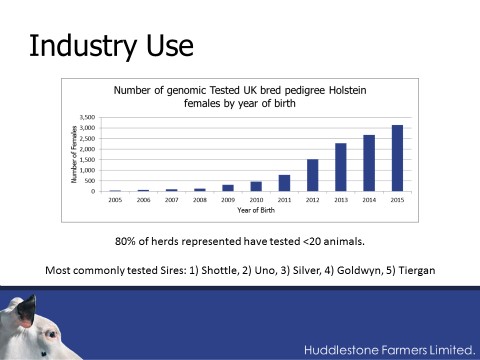
So how should we get best value from our testing? If you look at the animals farmers have tested they are in the main older animals. However, we already know quite a lot about our older cows. The animal we know least about is the maiden heifer, she is, on average going to have the best genetics, but there will be outlier’s both high and low. If we test calves as they hit the ground then we are in a position to de-select the poorest, and accurately mate the rest to provide the fastest genetic gain (Figure 2).
Figure 2: How to Test?
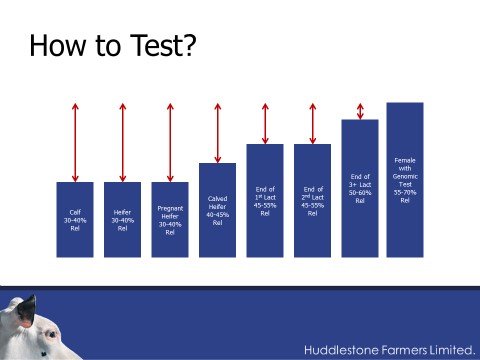
So why did we feel it was such a useful tool to us?
We are a profit motivated, science driven business, so it fits with our ethos, we are also early adopters of technology, although I mind my father’s words “Don’t’ be first be Second”!
Our Breeding Goals are:
- £PLI
- Fertility
- Lifespan
- Combined Kilo’s Fat and Protein
- Diversity - i.e. We look to have diversity within the herd, not on phenotype (we need cows that fit the system) but we like high yielding cows, high component cows, extreme fertility cows etc.
Would testing our animals gives us the information to best develop the herd on an individual basis?
We find that the response to good genetics pays. While AHDB Dairy tell us that a point increase in fertility will reduce calving interval by half a day we find at Huddlestone that one point = a whole day as seen in Figure 3 below.
Figure 3: Sire PTAFert Vs Days Open
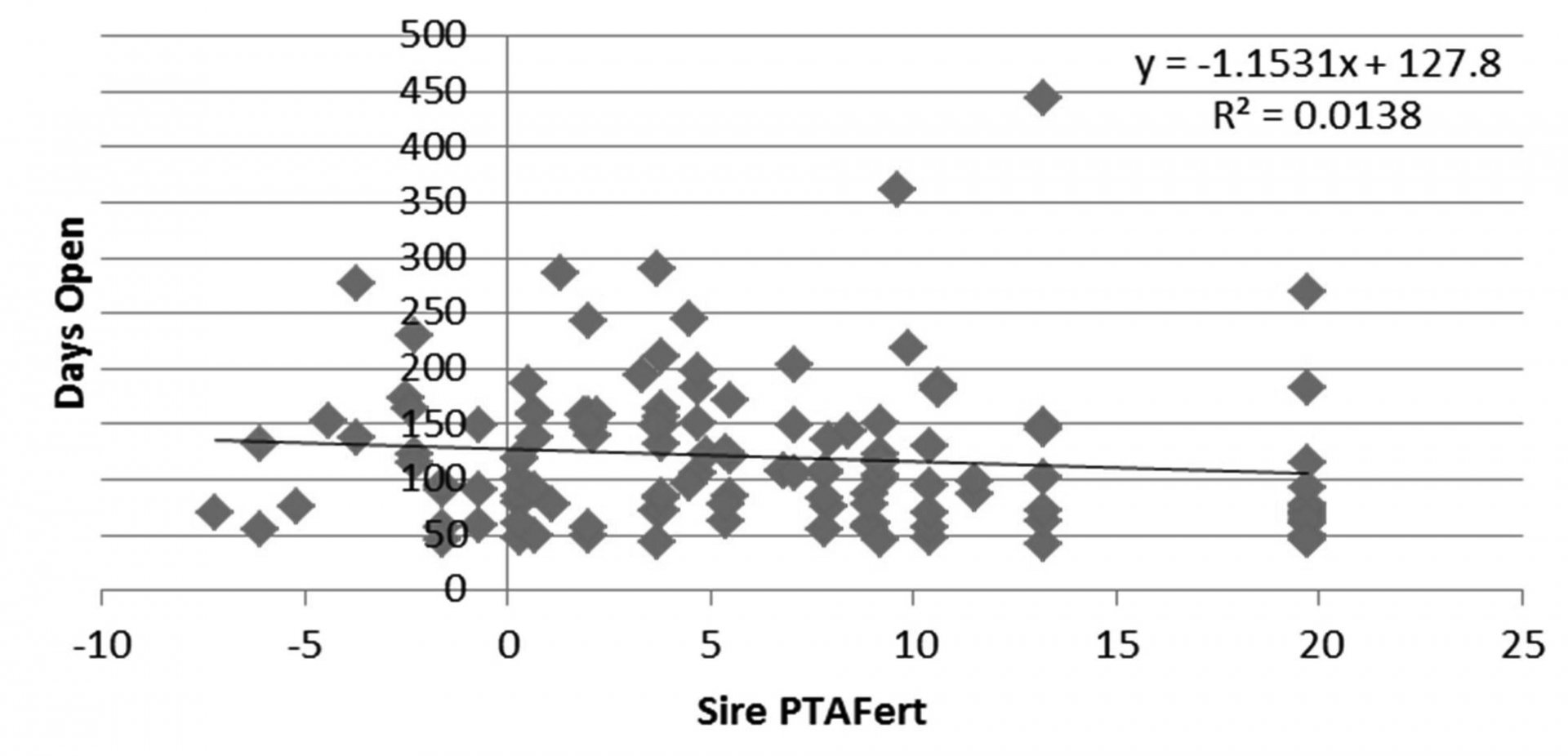
Similarly, if we look at milk, Figure 3A below shows response to milk yield, and again we see around twice the yield increase we would expect.
Figure 3A: Sire PTAM Vs 305ME
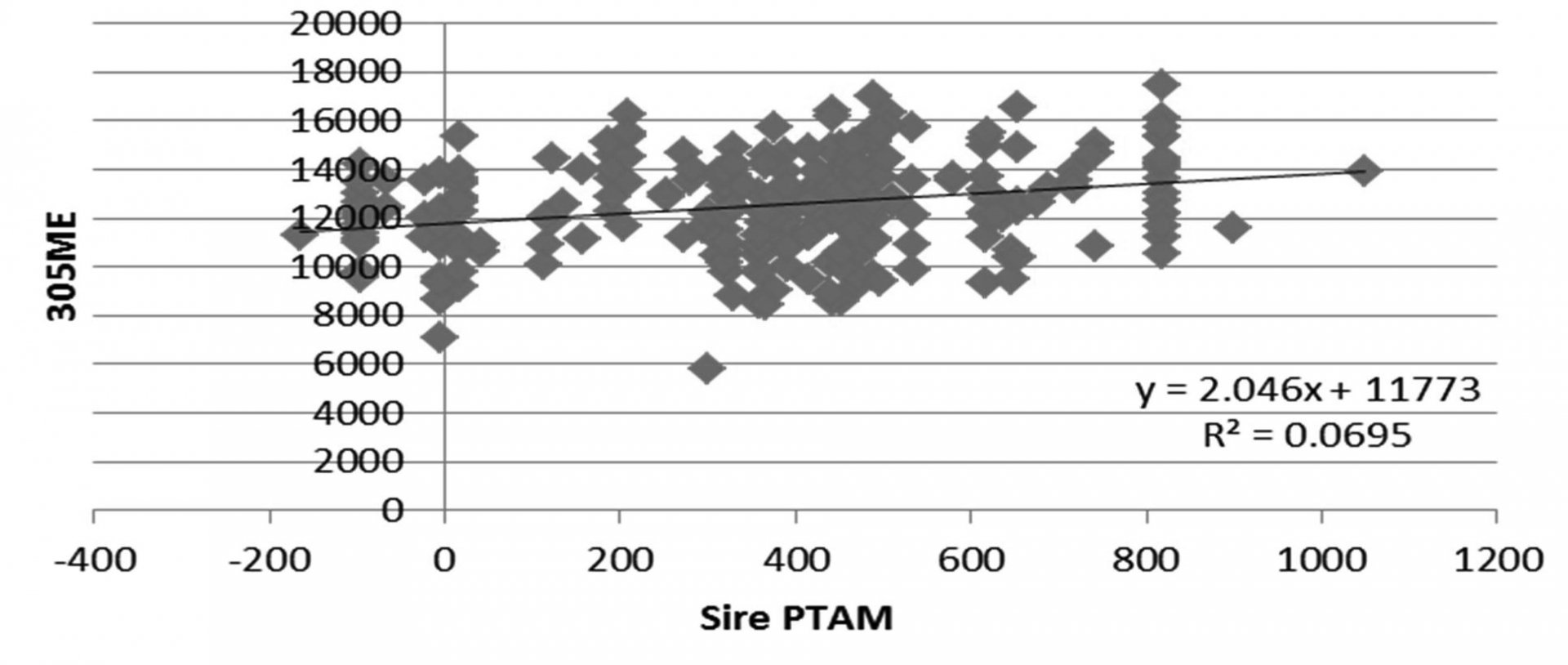
So we have faith in the science; indeed, we reap the rewards of using high PLI genetics.
- The results are real and beyond our expectations.
- This encourages us to accelerate genetic progress.
Up until recently we were really making the majority of our genetic progress by using good bulls. However, as we have been testing our calves since 2011 we have much more information and so are able to considerably increase the selection intensity on our female side.
Here we see the classic question, which is the best heifer. We have a pair of twins both with a P.A of £456 PLI. Having tested them we now know that one is considerably below PA and one above. Luckily both are pretty good animals in this case; but the real benefit of testing is not finding the high one’s but finding the low ones Figure 4.
Figure 4: Genetic Progress
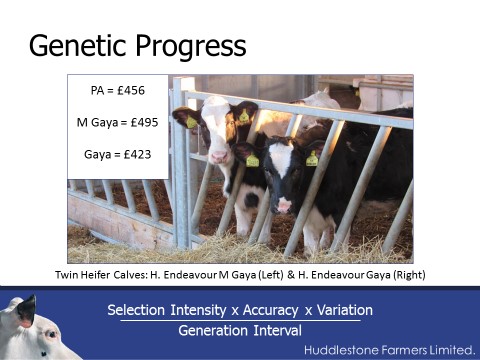
If we can eliminate breeding from the poorer animals, we apply much more selection intensity to our breeding program which results in better heifers and a more efficient herd.
Genomic testing allows us not only to be more selective but also to be much more accurate both in the choice of animals to breed from but also in the sire to select for each mating.
Variation is really in the hands of the AI industry; without variation we can’t make progress so they bear a huge responsibility here.
We have calved heifers at 2yrs old for 30 years but now that the best bulls are available sexed and we know which of our heifers are good enough to breed from, then over half of our heifers will come from heifers in the future, again reducing Generation Interval.
Again does it work?
Testing animals does not in itself make them more profitable!
While de-selecting the poorest gives the fastest genetic gain, finding the gems within the herd gives the validation.
In Figure 5 below is an example of how we find hidden gems.
Figure 5: Individual Validation
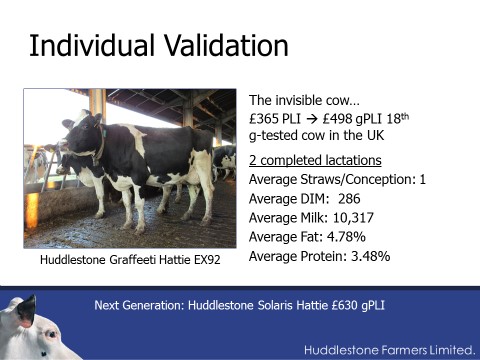
Hattie would have been a good animal within her peer group, but when we saw the results we were delighted to find she was outstanding, £133 PLI over PA, great functional type, high components and great fertility. So it has been proven, she has exceeded her genomic proof and is really the kind of cow we want a lot of in the herd. She is the 18th highest g-tested cow in the UK. Without genomics we would not have recognised her qualities, and with her Solaris daughter again considerably beating PA we have discovered an outstanding source of genetics for the future. People keep talking about the ‘invisible cow’; with genomic testing you can find her!
So much for the vanity, but does it pay?
Our herd is 420 strong and we serve 120 heifers a year. We will target 90 pregnancies from heifers mostly from sexed semen, and will serve 100 cows to dairy. If we were to select our top 100 heifers on P.A alone they would average (with the benefit of their genomic results) £399 gPLI, but if we use their genomic proofs to rank them then we select a group with an average gPLI of £450. Similarly, with cows, if we rank the top 100 on their non-genomic proof then they average £316 gPLI, but when ranked by gPLI their average is £330.
So if we apply that to the animals we will breed from this year then the Opportunity cost of serving the wrong animals is ~ £5480, against a cost of under £4000. A reasonable return and does not account for the carry over into future generations which is immeasurable.
What of the future?
I’m sure we have very little idea of what genomic testing will look like in 20 years, progress accelerates over time, 20 years ago very few people would have imagined the technology we take for granted today.
We will be able to utilise information better, by using genomic inbreeding we will accurately know how inbred animals are and to whom. We could be able to utilise chromosomal information to make better mating’s. It’s interesting to look at the cow I mentioned earlier H. Grafeeti Hattie, when we look at her Chromosomal PTA then the best gains would probably be on the first three chromosomes, as it happens Solaris is very strong on Chromosome’s 1-3 and that might explain how we got such a big win out of that mating.
Clearly we can accelerate genetic progress but there is always a cost, are we at a point where some funding should come from semen sales if the benefit can be demonstrated.
We need to maximise the value of each pregnancy, using the methods I have talked about, but in the future we will need better tools to make maximising the gains easier.
Should we be utilising other breeds? If we can identify those borderline animals which we wish to breed from, but in all probability their heifer calf will not qualify to breed another generation, then why not produce an F1 instead? Using good heifers to mate with the best of another breed should produce wonderful hybrids which could then be bred to beef Figure 6.
Figure 6: And in the Future?
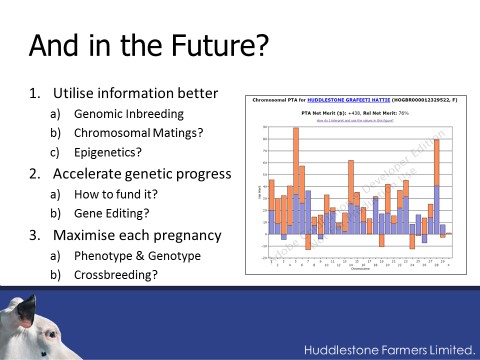
The future looks amazing! Other technologies that are not necessarily genomics, but are genetics, will give us unbelievable possibilities, if gene editing is allowed then all cattle will be polled as a first step, epigenetics will allow us a much greater understanding of how to get the best from our genetics. One thing is for sure, we ain’t seen nothing yet!